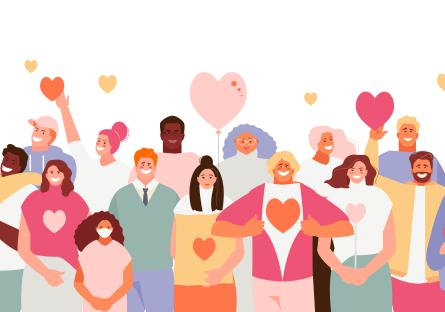This article appears for archival purposes. Any events, programs and/or initiatives mentioned may no longer be applicable.

Are you still trying to settle on a resolution for the new year? A great resolution to make is to try and be more generous. Being altruistic and giving isn’t just a moral good — it can be good for you! Helping others can have very real mental and physical health benefits. It’s the best of both worlds: you can make the world a better place while also bettering yourself.
Helper’s High
Humans are social animals and our brains are proof of that. We’re hard-wired to experience pleasurable feelings when we help each other through the release of neurochemicals like dopamine, serotonin, and oxytocin. When we help others it can trigger the release of these hormones which can create feelings of relaxation, social connection/bonding, and satisfaction. It also has an effect on our bodies: oxytocin is an anti-inflammatory and pain reducer; serotonin improves digestion and cognitive function; and dopamine affects your heart rate and blood pressure.
This cocktail of mood and physical enhancements that come from acts of generosity and community-building is called a helper’s high. It’s why it feels so good to do good.
Lower Blood Pressure
A surprising benefit of being generous is that it can lower your blood pressure. One study found that people who engage in "prosocial spending" (i.e. giving money to others) will often see a reduction in blood pressure and improved cardiovascular health. Experts believe this drop may be due to a reduced stress level that comes from being generous.
Ease Anxiety
Research has also found a correlation about altruistic behavior and reduced anxiety levels. Researchers have noticed that subjects who engage in “targeted” generosity (i.e. when we help specific people directly as opposed to donating to a charity) experience decreased activity in their amygdala. The amygdala is the brain’s epicenter for emotion in the limbic system, the part of your brain that triggers fight-or-flight responses. When your amygdala is more active, you’re more likely to feel anxious, stressed, possibly even subjected to phobias or instances of PTSD. By being a more giving person you’re keeping that fight-or-flight instinct nice and calm, which in turn will help you feel more relaxed and at ease.
It Has To Be Your Choice
There is an important caveat to all this: most of these beneficial effects can only be experienced if you actively choose to be generous. You can’t be compelled or forced to be giving and experience these benefits. So if you feel pressured to throw $20 in your company’s sponsored charity or reluctantly buy a friend’s daughter’s Girl Scout cookies, you’ll have done something good, but you won’t feel that helper’s high or experience a reduction in your blood pressure, stress, or anxiety levels.
Another important caveat is sincerity. Studies have also found that your motives for being generous matter. If you’re doing something altruistic purely to experience these benefits, you most likely will not actually enjoy those benefits. In order to feel that “helper’s high” you cannot be acting out of pure self-interest.